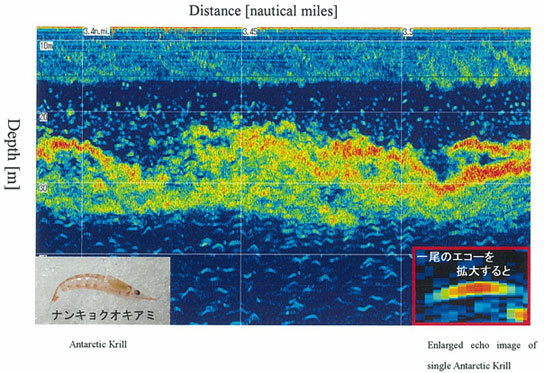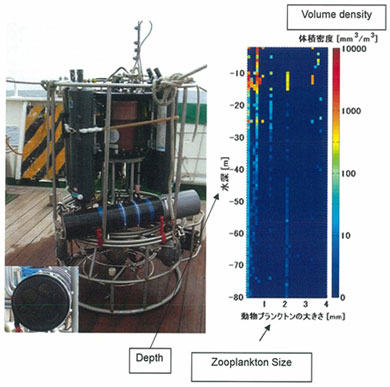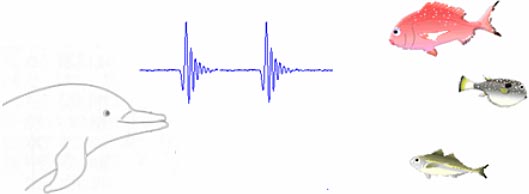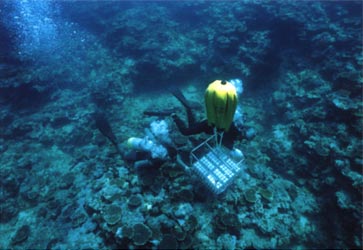| Research topics: |
 |
(1) |
The improvement of acoustic resource surveys of Antarctic krill |
|
Related instructor(s): Masahiko FURUSAWA |
|
Outline: |
Antarctic krill are a food source for whales and penguins and a key species in the Antarctic Ocean where humans also catch them. It is estimated that the abundance of Antarctic krill is nearly equal to the fish caught in the entire world. To learn the ecology and population size of the krill a sophisticated echo sounder known as a quantitative echo sounder is used. This topic conducts measurement and modeling research of the target strength and swimming behavior of the krill in order to improve the accuracy of abundance estimation by acoustic measurements. |
|
 |
|
Figure 1. Echogram of Antarctic krill. Analysis of such echoes allows us to know their abundance and behavioral ecology. |
 |
 |
(2) |
Research on acoustic measurement method for zooplankton |
|
Related instructor(s): Masahiko FURUSAWA |
|
Outline: |
Acoustic technologies are extending to measure distribution and abundance of zooplankton, as small as 0.2 mm in size. The use of multiple beams and multi and high frequency sound such as 1 MHz, which has been used for diagnostic instruments, allows observers to measure plankton target strength and quantity for each particular size. This topic conducts research into the practical and accurate application of new technologies such as these. |
|
 |
|
Figure 2. Multi-frequency plankton measurement system, TAPS (cylindrical object set horizontally; the lower left shows its end surface installing transducers for six frequencies), installed onto a suspension system (CTD) that measures water temperature, salinity, etc.. Also shown are distribution densities for each of the measured sizes. |
 |
 |
(3) |
Development of dolphin-type echo sounder |
|
Related instructor(s): Masahiko FURUSAWA |
|
Outline: |
Even in dark sea dolphins can detect, catch, and eat food fish using their bio-sonar, similar to echo sounder. It is thought that the dolphins perform high level species identification and size estimation by their sonar. Accordingly, this research topic attempts to incorporate the best aspects of their acoustic capabilities into artificial sonars. |
|
 |
|
Figure 3. Dolphins use short acoustic pulse known as clicks to detect, track, and catch fish for feeding. |
 |
 |
(4) |
Research and development of coral reef recovery technologies by applying sexual reproduction |
|
Related instructor(s): Mineo OKAMOTO |
|
Outline: |
Japan's and the world's coral reefs are facing a serious crisis due to rising sea temperatures caused by global warming. This has culminated in the dying out of corals due to the frequent coral bleaching that has occurred every few years since 1998. As a result not only does adult corals die, but the recruitment of juvenile corals that should be generated each year has undergone rapid depletion. The majority of Japanese coral is distributed along the Kuroshio Current. Japan's largest coral reef, the Sekisei Lagoon, is located at its source and is only just managing to continue reproduction (through mass spawning). As one method for preserving this corals, the research is furthering development of technologies for the large-scale raising of young corals for transplantation using the immense number of larvae born in the mass spawning. The juvenile corals are not so weak to bleaching as adult corals are. It is also expected that the zooxanthellae symbiotic micro algae in the coral polyps will develop to withstand increasing seawater temperatures. This prolonged research adheres to the pace of the coral itself and is characterized by all aspects of the research being conducted in the sea. |
|
 |
|
Figure 4. Installation of ceramic-made settlement devices to raise corals for transplantation (960 devices in one cage) prior to mass spawning of corals coral spawning at Irabu Island. |